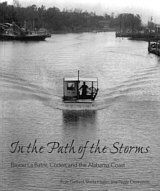  In the Path of the Storms
In the Path of the Storms
Bayou La Batre, Coden,
and the Alabama Coast
Frye Gaillard, Sheila Hagler
and Peggy Denniston
Pebble Hill Books / University of Alabama Press, 128pp, 25 b/w photos, 19.95
Spending the last several winters on the Alabama coast, my definition of boats, boating, fishing, fishing families and hurricanes (among other aspects of life on the water) has been radically altered. I have been searching for a contemporary book that deals with living and working on the water along this fragile coast. In the Path of the Storms is a rare and fine example. Although the impact of Hurricane Katrina on the small fishing village of Bayou La Batre, was the impetus, the oral histories and generational memories enrich this book far beyond a description of a single event, no matter how devastating.
In cooperation with the University of South Alabama, the Journal of American History decided to publish a special edition on the historical impact of Hurricane Katrina. Articles in that edition were presented at a conference, held at USA in the spring of 2007. Most focused, rightly, on New Orleans. However, Frye Gaillard, local writer in residence at USA was asked to focus on the Alabama coast. Immersing himself in the community of Bayou La Batre, he discovered a "rich and complicated culture," which, after he completed the Journal article, explored more fully for this book.
In the course of his research, Gaillard met Sheila Hagler and Peggy Deniston, two artists in residence in the Mobile County schools "who were already working with students and families to help them come to terms with the disaster." Most of the photographs in the book were taken by Hagler, a professional photographer; others by students and other residents.
The heart of the book is a compilation of first-person recollections from Bayou residents. Their Katrina experiences are, of course, predominant, but there is also a rich component of oral histories of the area in general and family histories, in particular, both oral and written, from the white and Asian populations who have peopled the area. (The fishing industry and its decline figures heavily and is a pervasive worry.)
In 1906, for instance, when Alma Bryant was 13, a hurricane blew for 24 hours in the Bayou. Her writings about the experience are excerpted in the book. One hundred and one years later the story of Sohpol Ngam and his family is partially quoted. They barely escaped the flooding of Katrina because they couldn't swim. (More than 2,000 people out of 2,300 were forced from their homes by wind destruction and/or rising water.)
In 1916 another hurricane swept across Dauphin Island and the Mississippi sound. Marie Grey and her family were rescued from Coden beach by Aunt Clara, a local midwife, in her horse and buggy. Grey's memories have been passed along orally.
The book is not simply a collection of hurricane stories, however. Gaillard gives a nod to Native Americans, then proceeds with a succinct overview of the early European settlements, tracing several of the more colorful and ambitious characters of past generations to current families. A separate chapter is devoted to the arrival and slow acceptance of Asian refugees, whose experiences of persecution, terror and escape from their native lands are among the most harrowing in the book.
The chapter devoted to Katrina presents the voices of the diverse population of this tiny town perched on the very edge of the land. The last chapter examines various possible futures for the town, nothing grandiose, but perhaps incrementally more diversely prosperous in spite of the fondly remembered and swiftly diminishing life line of commercial fishing.
|